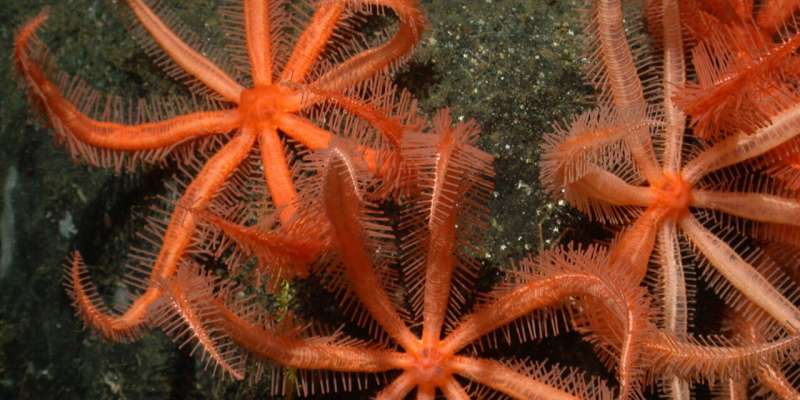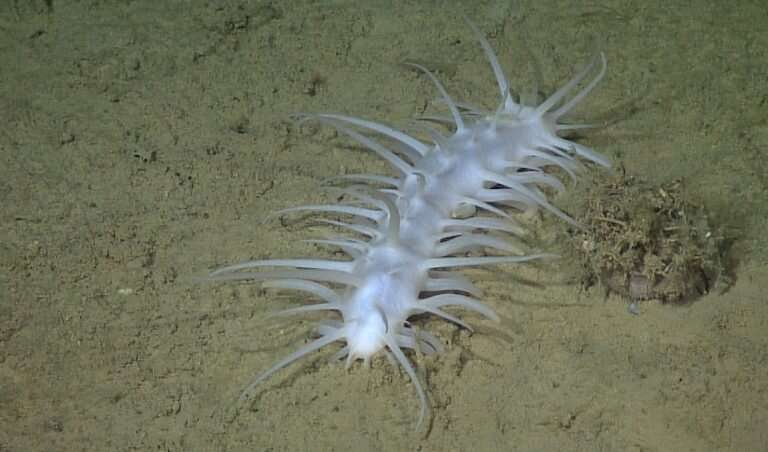This article has been reviewed according to Science X's editorial process and policies. Editors have highlighted the following attributes while ensuring the content's credibility:
fact-checked
peer-reviewed publication
trusted source
proofread
Researchers outline best practices for understanding life on the ocean's vast seafloor

Resource managers and policymakers need robust data about marine ecosystems for decision-making and setting sound policies. However, data about marine life can be challenging to collect, integrate, and analyze. Invertebrate animals are a key component of life on the seafloor, but their wide range of body sizes and diversity make it especially difficult to understand their abundance and distribution.
A new set of research practices—developed, in part, through the Deep Ocean Observing Strategy and Marine Biodiversity Observation Network—can help standardize the information researchers and ocean industry contractors collect about seafloor invertebrates. Led by Henry Ruhl, director of the Central and Northern California Ocean Observing System (CeNCOOS), an international team of researchers published their findings in Limnology and Oceanography Letters earlier this month.
"We're highlighting a common pathway for ecologists studying seafloor invertebrates. These best practices will make it much easier to combine data from various sources and methods. By standardizing the data we collect, we can provide more of the critical information that policymakers need to sustainably manage and protect the ocean," said Ruhl.
Researchers can use well-established tools and methods to collect information about the physical conditions of the ocean, like sea surface temperature. But collecting data about the biological communities below the ocean's surface is far more challenging.
Scientists have long recognized that marine invertebrates are a prominent part of seafloor communities. Sponges and snails, crabs and corals, worms and sea cucumbers—marine invertebrates occur across 71 percent of Earth's surface and come in sizes spanning 10 orders of magnitude, from half a microgram to five kilograms. Scientists are actively studying seafloor invertebrates and collecting a lot of data about these organisms.
However, scaling up information about seafloor communities in the same way as sea surface temperature has remained elusive. Researchers have struggled to move beyond individual studies to see broad-scale patterns, a critical step toward building ecological assessments that can inform management and policy.
For example, how can datasets that sample varying parts of the body-size spectrum, or use different sampling and observing methods, be combined in integrated assessments and modeling to advance our understanding of seafloor biomass, energy flow, and related ecological variables?
"The difficulty of integrating information across all size classes and diverse sampling methodologies has limited our ability to understand global patterns in invertebrate populations," explained Brian Bett, a deep-sea biologist at the National Oceanography Centre and a co-author on the study. "We'll struggle to distinguish natural variation, climate change, and other human impacts on seafloor ecosystems without being more effective in sharing and combining data."

Effective management of ocean ecosystems and resources hinges on a local-to-global effort. The CeNCOOS collaboration aims to translate data into action through the production, curation, and delivery of high-quality information about the ocean. CeNCOOS joins 11 other national regions to form the US Integrated Ocean Observing System, which in turn forms part of the Global Ocean Observing System (GOOS).
The team here included contributions from the National Oceanography Centre (UK), the University of Plymouth (UK), the Ocean Biodiversity Information System, the Intergovernmental Oceanographic Commission of the United Nations Educational Scientific and Cultural Organization (Belgium), Polytechnic University of Marche (Italy), and Florida State University (US).
As an intergovernmental effort, GOOS develops guidance to deliver the essential information needed for sustainable use of marine resources. GOOS helps coordinate a community of international, regional, and national ocean observing programs, as well as governments, UN agencies, research organizations, and individual scientists.
The international team has outlined five research practices that can establish a new GOOS Essential Ocean Variable (EOV) for benthic invertebrate abundance and distribution:
- Quantify individual body size.
- Identify the well-quantified portions of sampled body-size spectra.
- Take advantage of automated and semi-automated information processing via artificial intelligence and machine learning.
- Apply metadata standards, such as Darwin Core.
- Make data available through internationally recognized access points.
Among these practices, measuring body size is critical to harmonizing the diverse types of data that scientists around the world are collecting.
These practices enable broader-scale analysis supporting research and sustainable development, such as assessments of indicator taxa, biodiversity, biomass, and modeling of carbon stocks and flows across time and location.
Integrating data about seafloor invertebrates will allow researchers to leverage powerful new technologies, including artificial intelligence, to further transform our understanding of marine ecosystems.
Implementing these practices as a toolkit will help bridge the gap between science and policy to help manage the impacts of fisheries, oil and gas exploration, deep-sea mining, and climate change on marine life.
"All life on Earth depends on the ocean, but we can't manage or monitor the ocean without good data. Our team has identified how scientists around the world can harmonize the data they've collected about the ocean. Working together, this trove of biological data can guide sound policy to protect vital ocean resources," said Ruhl.
More information: Henry A. Ruhl et al, Integrating ocean observations across body‐size classes to deliver benthic invertebrate abundance and distribution information, Limnology and Oceanography Letters (2023). DOI: 10.1002/lol2.10332
Journal information: Limnology and Oceanography Letters
Provided by Monterey Bay Aquarium Research Institute



















